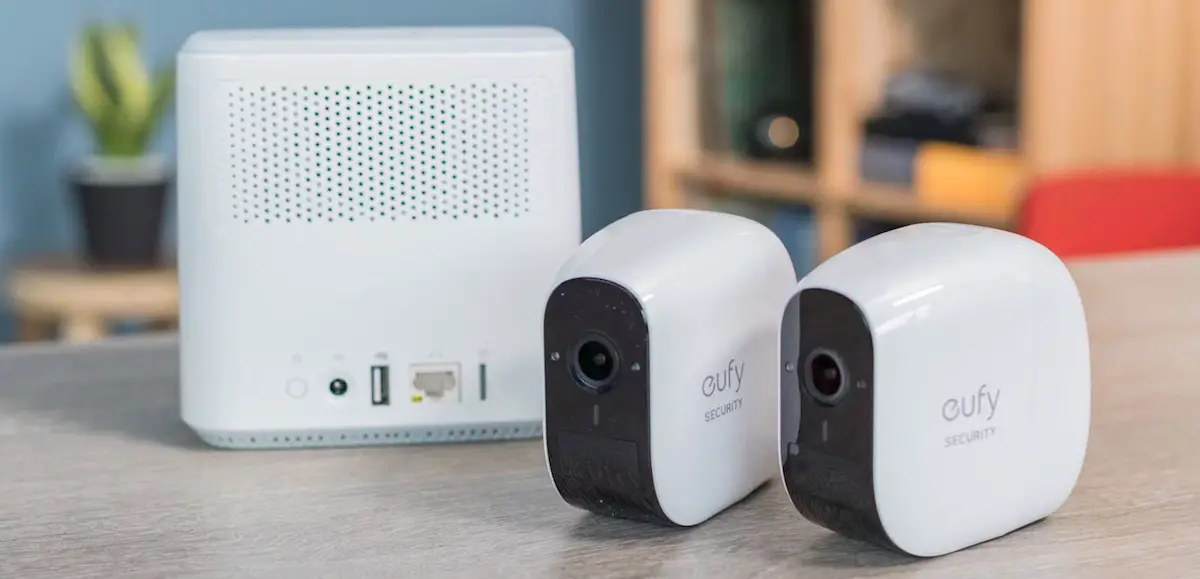Arlo Pro 2 has better smart home integration, and there are more advanced options for $3/month with Arlo Smart. EufyCam E has more free options and won’t send your clips to outside servers. All clips are stored on an SD card.
~~~ Check Price [Eufy Direct] ~~~
TL;DR
For those willing to pay for advanced features and better smart home integration, Arlo Pro 2’s quality and cloud storage make it a robust choice. However, if you prioritize free options, local video storage, and a camera system that doesn’t require WiFi to function, then EufyCam E’s longevity and user-friendly application provide a strong alternative.
Free Plans
Both Arlo and Eufy have free plans and they’re almost identical in this regard.
Arlo Basic is the free plan and it records both video and audio whenever the camera notices motion. It can record clips for up to five minutes. They are saved in Arlo’s cloud for 7 days and they can be saved to your device or computer for permanent storage. Unlike cameras from Nest and Ring, this free plan is fantastic for most people.
Connect a drive to the Arlo Base Station via a USB port to automatically save videos. If you do this, they’ll still be uploaded to the cloud and an internet connection is needed at all times.
Eufy is similar in that it records video and audio based on motion. While it only records two-minute clips, it will immediately record another clip if it still senses motion after the two-minute threshold, so no skips in between. All the footage is stored locally on a microSD card. It comes with a 16GB card (enough for 1,500 hours of footage), but you can buy a microSD card as big as 128GB.
The videos are encrypted and never leave the base station, so no WiFi is needed to record. You can view the videos from the app. Exporting videos to your device is simple.
Free winner: Eufy
Subscription
Willing to pay for some extra features? Normally this would compare the two devices, but Eufy doesn’t have a subscription plan. You get all the features upfront without ever paying a subscription service, so I’ll only cover Arlo’s paid plan.
Arlo Smart is only $3/month and it stores videos for 30 days rather than 7. You can set “Activity Zones” to prevent false alerts, which might be necessary for some people with lots of tree branches or cars driving by. Package detection seems good as it tracks when packages are delivered, but you must have a camera facing towards the ground, which you may or may not be able to spare depending on your home’s layout.
You get enhanced notifications with thumbnails and text-based notifications to let you know if the video is worth viewing quickly. There are three subscription tiers. You get 30-day storage for one camera for $3/month, the same storage for 10 cameras for $10/month, and 60-day storage for 20 cameras for $15/month. You can get 24/7 continuous recording for an extra $10/month and constant power is required.
Subscription winner: Arlo
Software
Even a great device can be ruined by poor software. Both Arlo and Eufy have great apps, but Arlo has more smart home compatibility.
The Arlo app has a fantastic interface. The basic features are front and center and the advanced features are simple to find. You can set detection rules, such as telling camera #2 to record if camera #1 detects motion. However, it takes a long time for the app to load and another few seconds for the live feed to load. Using Alexa or Google devices increases the loading time. The loading has gotten slower as I’ve tested over the years, so it seems more like a phone app issue than a server issue.
You can record live video with a tap. You can also schedule recordings or set geofencing locations to set off the camera. Arlo Pro 2 is compatible with Google Assistant and Alexa. You can play live video from both and you can even add Arlo to your Alexa Routines. This allows you to turn on lights or lock the doors when the cameras are triggered. One major benefit over Eufy is that Arlo is compatible with Apple HomeKit. While you can view the live feed and create automation routines, you can’t view recorded clips from Apple’s Home app.
There are great IFTTT routines like arming or disarming with your smart assistant, getting a warning when the batteries are low or creating motion triggers with Ring or Hue lights. The Arlo base station comes with a 100dB siren that can be triggered after an action or manually through the app.
Eufy’s app is basically a clone of Arlo’s interface, but it launches quicker and quickly loads clips and settings. Live video loads in three seconds. Tap the button to start recording the live feed. The app doesn’t tell you exactly how much battery power remains but represents it with four bars.
There are several modes to choose from. Home Mode records motion and sends notifications when the camera is triggered. Away mode is the same, but it turns on the alarms. Disarmed Mode turns everything off. Activity zones can be set so that motion outside the zone won’t be recorded. It should stop false alerts, but it isn’t 100% accurate. It works with Alexa and Google Assistant, but it’s more limited than Arlo.
You can bring up live feed, and even faster than Arlo, but you can’t create Alexa Routines. It doesn’t work with Apple HomeKit, but it did promise this later. There is no IFTTT support. There’s also no web-based interface. The app is great, which is great because that’s the best way to interact with these cameras.
Software winner: Arlo
Hardware
This refers to how well the camera and base station are made. They are very close, but EufyCam E has a slight edge because the base station doesn’t need to be plugged into the router, giving you more flexibility.
Arlo has fantastic build quality. Both the camera and mount are magnetic for easy installation. The base station plugs right into your router, the same as EufyCam. Cameras must be within 300 feet of the base station, so keep this in mind during installation. All the cameras are wireless and battery-powered, averaging about three months of battery life.
The cameras are IP65 certified to handle rain, sun, and extreme heat and cold. Amazon has $50 replacement batteries to avoid downtime. Plugging the base station into an outlet with a micro USB cable lets you record 24/7 (via Arlo Smart) and create activity zones. Arlo also has an optional solar panel, but since I haven’t tested it, I don’t know how well it works.
Eufy is nearly a clone of Arlo in terms of color, shape, and magnetic mount. However, there are three major differences. You can’t buy spare batteries, nor can you change the internal battery. This means the camera won’t work once the battery is bad, so expect about 2-3 years of service. You get two different mounts. One for inside and one for outside.
Eufy claims the battery lasts for a year before needing a charge (based on recording five minutes of video per day on the “optimal” battery life setting). I’ve tested this for three months and I still have full bars, so the claim seems to be right. In either case, the batteries last longer than Arlo. The cameras have the same IP65 rating for durability.
While Eufy claims the base station has the same 300-foot range, it was closer to 100 feet in my experience. You need to connect the base station to your router during installation, but you can disconnect the base station from your router and plug it in wherever you have WiFi. Ideally, you need a spot in your house that has strong WiFi and is close to the camera. The base station comes with a microSD card of 16GB. Both the base station and cameras have an alarm, unlike Arlo which only has an alarm on the base station, and you can set “Anti-Theft Detection” that sounds the alarm if either the camera or base station is moved.
Hardware winner: Eufy
Record Quality
This refers to recording quality. The two are very close here, but EufyCam has a slight edge. Check out this video for more.
Arlo shoots in 1080p and has a 130-degree field of view. The resolution is much better than other 1080p cameras I’ve used, like Ring and Blink XT2. It’s also a big upgrade from Arlo Pro 1. You can zoom in and identify someone’s face from about 20 feet away. Arlo uses 8=eight infrared LEDs and night vision, but faces look blurred compared to Eufy’s night vision. There’s a three-second lag between the live feed and what’s happening, making two-way communication challenging.
Eufy also records in 1080p with a larger 140-degree field of view. It only has two infrared LEDs, but they provide more light for better night vision. The mic is very sensitive and can pick up voices from far away, but the voices aren’t clear.
Record quality winner: Eufy
Final Thoughts
Eufy cloned many aspects of Arlo, but they did things like recording quality and app speed better than Arlo. Plus, Eufy is great if you want a camera that records locally without going to the cloud. It’s what I recommend to those who don’t plan to pay for a subscription. Arlo Pro 2 is a more refined product because it offers more advanced features (with Arlo Smart) and more smart home integrations.
FAQs
What is the video quality for Arlo Pro 2 and EufyCam E?
The Arlo Pro 2 records video in 1080p resolution while the EufyCam E also offers 1080p HD resolution. Both provide clear and detailed videos which are crucial for identifying faces or other specific details.
Can I integrate these cameras with my existing smart home setup?
Yes, both cameras can be integrated with smart home systems. The Arlo Pro 2 supports integration with Google Assistant, Alexa, and even Apple HomeKit. On the other hand, EufyCam E also supports Google Assistant and Alexa, but its compatibility with Apple HomeKit may still be in progress.
How safe are my recordings with these devices?
The Arlo Pro 2 uses cloud storage for your recordings, ensuring your videos are stored safely off-site. However, if privacy is your concern, EufyCam E stores all videos locally on a microSD card, keeping your recordings within your control.
Do Eufy & Arlo cameras offer free plans?
Yes, both cameras offer free plans which allow recording of video and audio based on motion detection. Arlo allows for 7-day storage in the cloud while EufyCam provides local storage on a microSD card.
What are the subscription options for these devices?
While Eufy doesn’t offer a subscription service, Arlo offers Arlo Smart starting at $3/month, which gives additional features such as 30-day storage, advanced object detection, and enhanced notifications.



